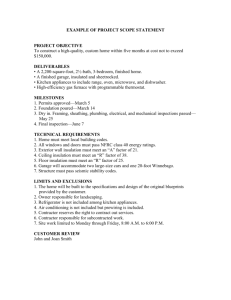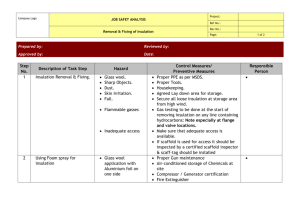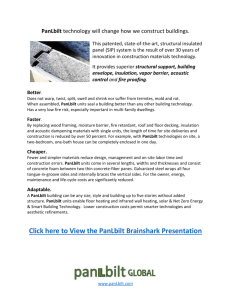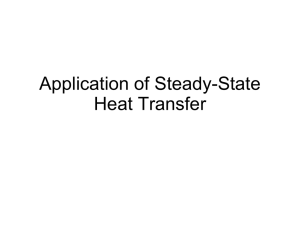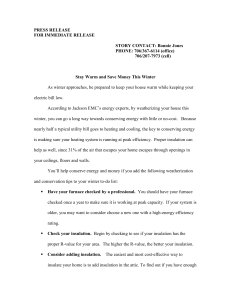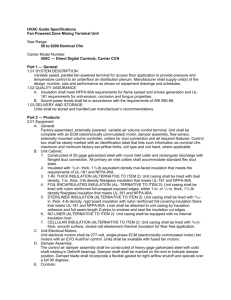section 15250 - mechanical systems insulation
advertisement
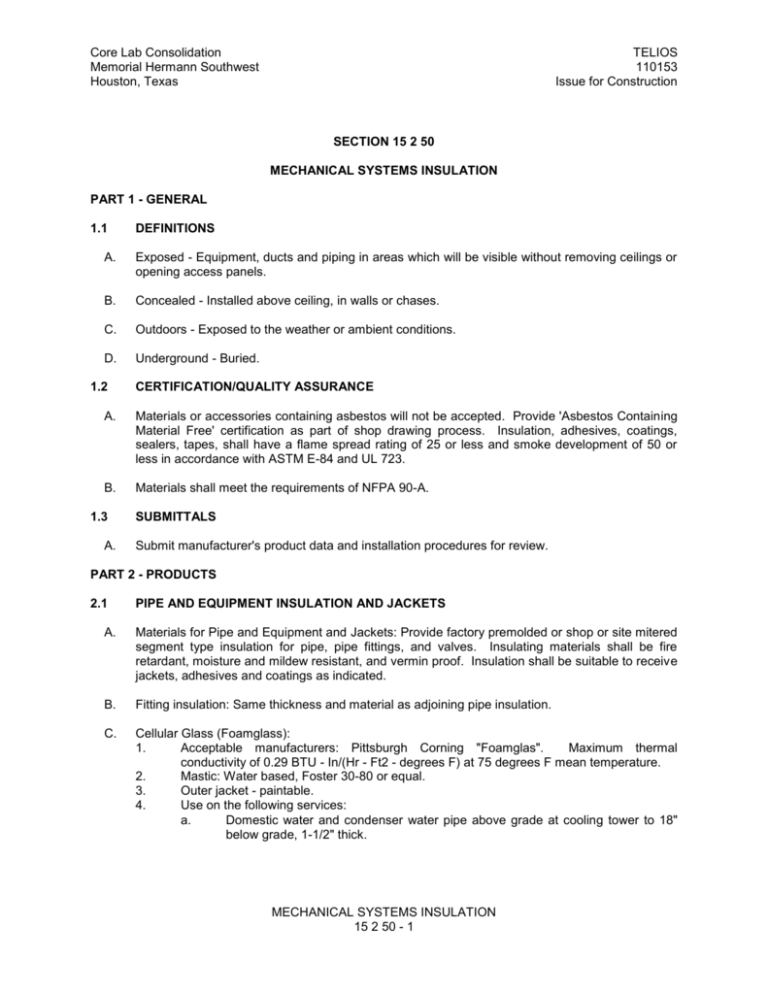
Core Lab Consolidation Memorial Hermann Southwest Houston, Texas TELIOS 110153 Issue for Construction SECTION 15 2 50 MECHANICAL SYSTEMS INSULATION PART 1 - GENERAL 1.1 DEFINITIONS A. Exposed - Equipment, ducts and piping in areas which will be visible without removing ceilings or opening access panels. B. Concealed - Installed above ceiling, in walls or chases. C. Outdoors - Exposed to the weather or ambient conditions. D. Underground - Buried. 1.2 CERTIFICATION/QUALITY ASSURANCE A. Materials or accessories containing asbestos will not be accepted. Provide 'Asbestos Containing Material Free' certification as part of shop drawing process. Insulation, adhesives, coatings, sealers, tapes, shall have a flame spread rating of 25 or less and smoke development of 50 or less in accordance with ASTM E-84 and UL 723. B. Materials shall meet the requirements of NFPA 90-A. 1.3 A. SUBMITTALS Submit manufacturer's product data and installation procedures for review. PART 2 - PRODUCTS 2.1 PIPE AND EQUIPMENT INSULATION AND JACKETS A. Materials for Pipe and Equipment and Jackets: Provide factory premolded or shop or site mitered segment type insulation for pipe, pipe fittings, and valves. Insulating materials shall be fire retardant, moisture and mildew resistant, and vermin proof. Insulation shall be suitable to receive jackets, adhesives and coatings as indicated. B. Fitting insulation: Same thickness and material as adjoining pipe insulation. C. Cellular Glass (Foamglass): 1. Acceptable manufacturers: Pittsburgh Corning "Foamglas". Maximum thermal conductivity of 0.29 BTU - In/(Hr - Ft2 - degrees F) at 75 degrees F mean temperature. 2. Mastic: Water based, Foster 30-80 or equal. 3. Outer jacket - paintable. 4. Use on the following services: a. Domestic water and condenser water pipe above grade at cooling tower to 18" below grade, 1-1/2" thick. MECHANICAL SYSTEMS INSULATION 15 2 50 - 1 Core Lab Consolidation Memorial Hermann Southwest Houston, Texas TELIOS 110153 Issue for Construction D. Closed Cell Phenolic Insulation 1. Acceptable Product and Manufacturer: Koolphen K manufactured by Kingspan Corporation with maximum thermal conductivity of 0.13 BTU - In/(Hr - Ft2 - degrees F) at 75 degrees F mean temperature. Maximum water absorption of 0.10 Lb./SF. 2. Mastic: Vapor barrier type - Childers CP-30 CHILPERM or equal. 3. Outer Jacket - Paintable. 4. Use the following services: a. Underneath cooling coils on built-up units, 2" thick. b. Cooling tower basin, 2" thick. c. Chilled water piping, 2" and less pipe, 1-1/2" thick, 2-1/2" and greater, 2" thick. E. Flexible Tubular Elastomeric: 1. Provide fire-retardant closed-cell slip-on flexible type. Maximum thermal conductivity of 0.27 BTU - In/(Hr - Ft2 - degrees F) at 75 degrees F mean temperature. 2. Acceptable manufacturers: Armacell "AP ARMAFLEX"; Rubatex. 3. Use on the following services: a. Moisture condensate drains - 1/2" thick. b. Refrigerant lines for kitchen freezer and cooler suction - 1-1/2" thick (2 layers each 3/4" thick). F. Flexible Sheet Elastomeric: 1. Provide closed-cell flexible sheet type. Maximum thermal conductivity of 0.27 BTU In/(Hr - Ft2 - degrees F) at 75 degrees F mean temperature. 2. Acceptable manufacturers: Armacell, AP Armaflex, Rubatex. 3. Use on the following services: a. Refrigeration machine cooler, suction piping, and pipe connections: 1-1/2" thick (2 layers of 3/4" each). b. Chilled water pump casings and flanges: 1" thick (2 layers of 1/2" each). c. Plate and Frame Heat Exchanger: 1" thick (2 layers of 1/2" each). G. Fiberglass Pipe Insulation: 1. Acceptable manufacturers: Johns-Manville "Micro-Lok 850"; CertainTeed; Knauf; Owens Corning. Foster Jacket: ASJ fiberglass reinforced kraft paper with aluminum foil. Maximum thermal conductivity of 0.23 BTU - In/(Hr - Ft2 - degrees F) at 75 degrees F mean temperature. 2. Use on the following services: a. Domestic hot water supply piping and recirculating piping - 1-1/2" and less - 1" thick; 2" and greater - 2" thick. b. Domestic cold water piping - in exterior walls and all locations subject to condensation - 1/2" thick. c. Horizontal rain water leaders and roof drain bodies - 1" thick. d. Heating hot water piping, Runouts to terminal units(12 feet or less) 1-1/2"" and less - 1" thick; 2" and greater - 2" thick. e. Steam condensate piping, 2" and under - 1-1/2" thick; 2-1/2" and greater - 2" thick. f. Steam piping to 30 psi, 1-1/2" and under - 1-1/2" thick; 2" and greater - 3" thick. g. Steam piping 31 to 60 psi, 1" and under - 2" thick; 1-1/4" to 1-1/2" - 2-1/2" thick; 2" and over - 3" thick. h. Steam piping 61 to 425 psi, 1-1/2" and under - 2-1/2" thick; 2-1/2" to 4" - 3" thick; 5" and over - 3-1/2" thick. i. Steam converter - 3" thick. j. Kitchen dishwasher final rinse booster heater - 2" thick MECHANICAL SYSTEMS INSULATION 15 2 50 - 2 Core Lab Consolidation Memorial Hermann Southwest Houston, Texas k. l. m. n. o. TELIOS 110153 Issue for Construction Boiler trim including boiler feed water lines and blow down piping, - 1-1/2" thick. Vent piping from relief valves - 1-1/2" thick. Condensate receiver tanks and vent piping - 1-1/2" thick. Steam absorption chiller generator and piping - 1-1/2" thick. Drain bodies, traps and horizontal drain lines receiving cold condensate - 1/2" thick. Apply insulation a minimum of 20-feet downstream of drain connection. H. Calcium Silicate: 1. Noncombustible hydrous calcium silicate, 15 PCF density, maximum thermal conductivity of 0.55 at 500 degrees F. 2. Acceptable manufacturers: Johns-Manville "Thermo-12 Gold". 3. Covering: ASJ fiberglass reinforced kraft paper with aluminum foil. 4. Use on the following services: a. Boiler breeching, boiler stacks within boiler room, steam supply headers at boilers and incinerator breaching - 2-1/2" thick. b. Muffler and exhaust pipe inside building on emergency generator - 2" thick. c. Deaerator tank, unless factory preinsulated. d. Blowdown separator, including vent and drain connections and piping (except piping in trench). I. Semi-Rigid, High Temperature, Fiberglass Board Insulation: 1. Noncombustible semi-rigid, high temperature, fiberglass board insulation, 500 degrees F. or greater, snap on jacket, 3 pounds per cubic foot density, minimum "R" of 2.63. Insulation to be 3 pounds per cubic foot density and with minimum "R" value of 2.63 per inch. 2. Jacket: Aluminum or ASJ as described below. 3. Acceptable manufacturers: CertainTeed; Johns-Manville; Owens Corning; Pittsburgh Corning 4. Use for the following services: a. Boiler breeching with boiler room: 2-1/2" thick with ASJ jacket. b. Boiler stacks within boiler room: 2-1/2" thick with ASJ jacket. c. Gas fired absorption generator stack 2-1/2" thick with ASJ jacket. d. Steam supply piping from boiler outlet to main steam header and main steam header at boiler: 2-1/2" thick with ASJ jacket. e. Deaerator tank, if not factory insulated: 2" thick and covered with aluminum jacket. f. Absorption chiller: Generator and absorber sections: 2" thick with ASJ jacket. g. Domestic hot water tanks, if not factory insulated: 2" thick covered with ASJ jacket. h. Blowdown separator including vents and drain connections: 2" thick covered with ASJ jacket. J. Flexible High Temperature Blanket: 1. Noncombustible highly vibration-resistant glass fiber mat type, 11 pounds per cubic foot density, 1200 degrees F, minimum "R" of 2.78 at 400 degrees F. of 2.78 at 400 degrees F mean temperature completely closed in. 2. Acceptable manufacturers: Johns-Manville "Glass-Mat 1200", CertainTeed, Owens Corning, Pittsburgh Corning. 3. Use on the following services: a. Emergency generator flexible connections inside building - 2-1/2" thick. b. Muffler and exhaust pipe inside building on emergency generator: 2" thick covered with aluminum jacket. MECHANICAL SYSTEMS INSULATION 15 2 50 - 3 Core Lab Consolidation Memorial Hermann Southwest Houston, Texas 2.2 TELIOS 110153 Issue for Construction DUCTWORK INSULATION A. Blanket Type Duct Insulation: 1. Minimum 3/4 pound per cubic foot density, factory-reinforced foil-faced, kraft vapor barrier, with a maximum thermal conductivity of 0.29 BTU - In/(Hr - Ft2 - degrees F) at 75 degrees F mean temperature. 2. Acceptable manufacturers: Johns-Manville, CertainTeed, Knauf, Owens Corning. 3. Use on the following: a. Supply air ductwork - 2" thick. b. Supply air diffusers - 2" thick. c. Make-up air ductwork - 2" thick. d. Ductwork supplying outside air - 2" thick. e. Return air ductwork, unlined and installed on ductwork in ceiling space below roof or unconditioned space up to wall extending to deck - 2" thick. f. Reheat coils, including reheat coils at terminal boxes. B. Board Type Duct Insulation: 1. Provide minimum 3 pound per cubic foot density semi-rigid, factory-reinforced foil faced Kraft vapor barrier glass fiber board "system" type insulation, having a maximum thermal conductivity of 0.23 BTU - In/(Hr - Ft2 - degrees F) at 75 degrees F mean temperature. 2. Acceptable manufacturers: CertainTeed CB-300; Johns-Manviller, Knauf, Owens Corning. 3. Use on the following services in mechanical equipment rooms and exposed areas: a. Supply ducts within equipment rooms - 2" thick. b. Return air ductwork within equipment rooms - 1-1/2" thick. c. Apparatus casing - 2" thick. d. Outside air intake plenums and ductwork and connections to mixing plenums of heating and ventilating units - 2" thick. 2.3 MATERIALS FOR FITTINGS, VALVES, AND SPECIAL COVERINGS A. Use premolded insulation for pipe fittings, elbows, tees, butterfly valves, and couplings 2-1/2 and larger. Finish shall be as specified under "Products" herein. B. PVC Fitting Covers and Jackets: White PVC film, gloss finish one side, semi-gloss other side, FS LP-535D, Composition A, Type II, Grade GU. Ultraviolet inhibited indoor/outdoor grade to be used where exposed to high humidity, ultraviolet radiation, in kitchens or food processing areas or installed outdoors. Jacket thickness to be minimum .02" indoors/.03" outdoors for piping 12" and smaller, .03" indoors/.04" outdoors for piping 15" and larger. PVC fitting covers may be used over the premolded insulation for: 1. Chilled Water 2. Heating Hot Water 3. Domestic Cold Water 4. Domestic Hot Water 5. Domestic Hot Water Recirc. C. PVC fitting covers with fiberglass inserts may be used on piping fittings elbows and valves 2" and less for the following services: 1. Chilled Water 2. Heating Hot Water 3. Domestic Cold Water MECHANICAL SYSTEMS INSULATION 15 2 50 - 4 Core Lab Consolidation Memorial Hermann Southwest Houston, Texas 4. 5. TELIOS 110153 Issue for Construction Domestic Hot Water Domestic Hot Water Recirc. D. For tanks, heat exchangers and large pipes in systems operating over 60 degrees F. when exposed-to-view inside building or in equipment rooms, cover insulation with a smoothing coat of Keane Powerhouse cement, one layer of white colored woven glass fabric embedded and finished with Foster G-P-M mastic. E. For pipe fittings, valves, strainers, and other irregular surfaces, in chilled water or refrigerant systems operating below 60 degrees F, when inside building or in equipment rooms, cover insulation with white colored woven glass fabric embedded in white vapor barrier coating, Foster 30-35 or equal. F. For any service when above grade exposed-to-the-weather outside building, cover straight pipe insulation with 0.016" thick aluminum jacket equivalent to ITW Pabco/Childers and cover fittings with factory formed covers equivalent to Childers Elljacs. G. For any service, except for steam and steam condensate, when below grade direct buried, cover straight pipe and fitting insulation with equivalent of Pittsburgh Corning "Pittwrap" or "Pittcoat No. 300 with PC Fabric 79". Valves in systems operating above 60 degrees F and installed in valve boxes shall not be insulated, however the valves shall be painted with rust-resistant product equivalent to Rustoleum. H. For flexible tubular elastomeric pipe and fitting insulation when exposed-to-view inside building or exposed to the weather, finish with two coats of fire retardant self-extinguishing vinyl lacquer type highly flexible coating equivalent to Armstrong "WB Armaflex Finish", custom color blended to match surrounding surfaces. Do not tint finish where exposed to weather. I. For externally insulated sheet metal ducts when above grade exposed-to-the-weather outside building, cover duct insulation with glass mesh embedded and adhered to insulation using air drying weatherproof plastic fabricated cutback asphalt adhesive and finish with two coats of gray color flexible fire retardant protective coating having proven ability to withstand to wide range of temperature without cracking or crazing and be highly resistant to damage by bumping and abrasing, equivalent to Foster Weatherite 36-25/46-25. PART 3 - EXECUTION 3.1 INSTALLATION - GENERAL A. Deliver and store insulation materials in manufacturer’s containers and kept free from dirt, water, chemical and mechanical damage. B. Complete piping and ductwork pressure testing prior to applying insulation. C. Apply insulation in workmanlike manner by experienced, qualified, workmen. D. Surfaces shall be clean and dry when covering is applied. Covering to be dry when installed and before and during application of any finish, unless such finish requires specifically a wetted surface for application. E. Adhesives, cements and mastics shall be compatible with materials applied and shall not attack materials in either wet or dry state. MECHANICAL SYSTEMS INSULATION 15 2 50 - 5 Core Lab Consolidation Memorial Hermann Southwest Houston, Texas TELIOS 110153 Issue for Construction F. Stop duct coverings, including jacket and insulation, at fire penetrations of fire or smoke rated partitions, floors above grade and roofs. "Fan-out" or extend jacketed insulation at least 2" beyond angle frames of fire dampers and secure to wall. Maintain vapor barrier. G. If new insulation is being used at an existing facility, it shall be identified with blue painted labeling as "NON-ACM" with 2" high letters on 10' centers. 3. 2 BLANKET TYPE DUCT INSULATION A. Apply jacketed blanket type glass fiber covering to ducts pulled snug but not so tight as to compress corners more than 1/4". Use insulation having 2" tab, or cut insulation long enough to allow for "peel-off" of insulation from jacket to affect a minimum overlap of 2". Staple lap with flare type staples on 1" centers. Cover standing seams, stiffeners, and braces with same insulation blanket, using 2" jacket lap and staple lap as herein before outlined. Cover and seal all staples with Foster 30-80 reinforced with glass cloth. Do not use pressure sensitive tape. B. Secure jacket to covering using equivalent of Foster No. 85-20 or Childers CP-82 adhesive. C. For ducts 24" or wider, mechanically fasten insulation to duct bottom, using weld pins (only) having self-locking, metal discs, locating fasteners on not over 12" centers laterally and longitudinally. Seal pins as above. D. For ducts up to 18" deep, mechanically fasten insulation to duct sides, using one row of pins, plates or discs located on not over 12" centers longitudinally and equidistant laterally between duct top and bottom. For ducts over 24" deep, apply fasteners as before only using minimum of two rows. E. For supply air diffusers, apply jacketed blanket type glass fiber covering from connection neck to diffuser edge. Seal edge with Foster 30-80 reinforced with glass cloth. Do not seal to ceiling or lay-in T-bar. Diffuser shall be able to be lifted out without disturbing insulation seal. 3.3 BOARD TYPE DUCT INSULATION A. Apply jacketed board type glass fiber covering to ducts using weld pins having self-locking coated metal or nylon discs; locate fasteners on not over 12" centers laterally and longitudinally. If insulation is grooved to fit around corners, in order to eliminate as many joints as possible, pin as required to hold insulation tight to duct, especially on bottom of duct. Seal pins and joints with Foster 30-80 reinforced with glass cloth. B. Cover all joints, rips, tears, punctures, disc heads, staples, or breaks in vapor barrier jacket with 4" wide woven glass fabric tape embedded in equivalent of Foster 30-80 vapor barrier, fire resistant adhesive. Do not use pressure sensitive tape. 3.4 A. CALCIUM SILICATE INSULATION Apply calcium silicate covering to ducts and breaching in 2" thick layers with blocks tightly butted, joints broken. Secure with 16-gauge copper wire and/or stainless steel bands. Finish with wire mesh and hard coat of hydraulic setting cement. Apply same insulation and thickness to all duct or breaching hangers at least 12" up or to supporting structure. Double insulate duct or breaching when passing through floor or roof slab. MECHANICAL SYSTEMS INSULATION 15 2 50 - 6 Core Lab Consolidation Memorial Hermann Southwest Houston, Texas 3.5 A. 3.6 TELIOS 110153 Issue for Construction FLEXIBLE SHEET ELASTOMERIC INSULATION Prior to application of flexible sheet elastomeric insulation, thoroughly clean all metal surfaces, making sure that all dirt, scale, loose paint, plaster, and oil has been removed and that surfaces are dry. If surface has been primed, test a two square foot section using adhesive equivalent to Armstrong No. 520 in order to determine whether solvent in adhesive will loosen or lift the primer. If primer is loosened, then remove it. When testing proves acceptable, adhere insulation with smooth side out, using thin but adequate coating of same adhesive. Follow manufacturer's instructions. Coat all butt edges of each sheet. Stagger all joints. Insulate all standing seams or flanges with same thickness of insulation material as that used on main surface. INSTALLATION OF PIPE AND EQUIPMENT COVERING A. Where glass fiber, flexible tubular elastomeric, or closed cell phenolic insulation is used on piping sized 2" and larger, insert a section of foamglass or calcium silicate insulation, at hanger or support points, between pipe and metal shield for full length of shield, to prevent crushing of insulation. Where insulation passes through pipe hangers and across trapeze supports, 12" long metal saddles shall be used. Insulation thickness to be same as adjoining insulation. On cold pipe, vapor barrier should be carried through the hanger and sealed. Saddles shall be used where rigid foamglass or closed cell phenolic inserts are not acceptable. B. Foamglass or closed cell phenolic insulation shall be strictly applied as follows: 1. Both the circumferential and longitudinal joints shall be buttered with fire-resistive pliable sealer. Voids and cracks shall be filled with sealer. Mastic shall be Foster 30-80 or equal. Secure insulation with 3/4" wide x 0.010" thick aluminum bands on 8" centers. 2. The circumferential joints shall be staggered. 3. Fittings, valves, flanges, traps, and air vents shall be insulated with the same thickness of insulation using factory fabricated fitting sections or pre-molded insulated fittings. 4. Block type insulation shall be adhered by stick-clips or bands, in addition to the sealer, as required to provide support for the insulation. 5. Finish above furred ceilings and in chases shall be the bare insulation. 6. Finish in equipment rooms and elsewhere where exposed-to-view shall be white 8 oz canvas paintable jacket. 7. Finish where exposed-to-the-weather shall be .016 inch thick, ITW Pabco/Childers, or equal, aluminum jacket on lines and Childers Elljacs, or equal, pre-formed aluminum covering on fittings. 8. Finish on underground insulation shall be Pittsburgh Corning Pittwrap as recommended by manufacturer. C. Apply flexible tubular elastomeric insulation to pipe and fittings with all joints tightly fitted and sealed with adhesive. D. Apply semi-rigid high temperature, fiberglass board insulation as recommended by the manufacturer. E. Apply flexible high temperature blanket type in two steps. First, cover fitting with 1/2" thick matt only; then apply finished envelope containing 2" thick matt material. Secure envelope using stainless steel or monel bands, hooks washers, and lacing. MECHANICAL SYSTEMS INSULATION 15 2 50 - 7 Core Lab Consolidation Memorial Hermann Southwest Houston, Texas 3.7 TELIOS 110153 Issue for Construction INSULATION OF REFRIGERATED WALK-IN BOX PENETRATIONS A. Insulate all piping and conduit through box ceiling, walls and partitions, using foamed-in-place polyurethane. Finish penetration points using two-piece locking (overlapping) escutcheons fabricated from same quality metal as adjoining surface, and fix in place with galvanized sheet metal screws. B. Insulate the following, using 3/4" thick elastomeric pipe insulation, being careful to maintain the integrity of the vapor barrier: 1. Condensate drain piping. Condensate drain piping from the freezer shall be heat taped prior to installation of insulation. C. Refer to previously specified refrigerant suction and hot gas line piping insulation. 3.8 A. REFRIGERATION MACHINE INSULATION Insulate evaporator shell with two layers of 3/4" thick flexible sheet elastomeric. Insulation shall be applied prior to initial chiller operation on site. 1. Fit insulation to the curvature of the shell. 2. Insulate refrigeration lines, chilled water pipe connection housing, oil cooler piping, purge lines, steel foundation structure and other parts of chiller subject to sweating. 3. Make allowance for removable of bolts and nuts by tapering the insulation at these points. 4. Provide removable, insulated, sheet metal access section over both water boxes. 5. Stagger seams on multiple layer installations. 6. Seams and butt-joints shall be adhered and sealed with Armaflex 520 or 520 BLV adhesive. 7. All exposed, cut ends of insulation shall be coated with Armaflex 520 or 520 BLV adhesive. 8. Paint with two coats of white WB Armaflex finish. END OF SECTION MECHANICAL SYSTEMS INSULATION 15 2 50 - 8
